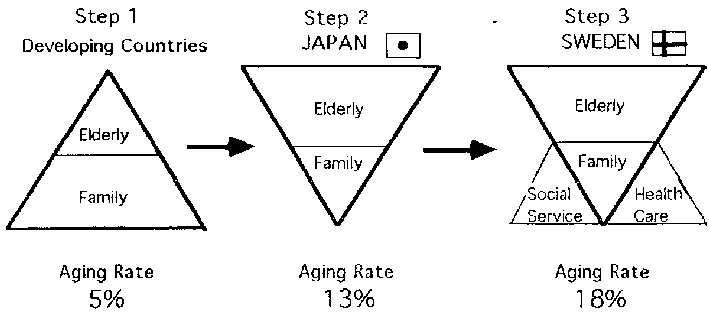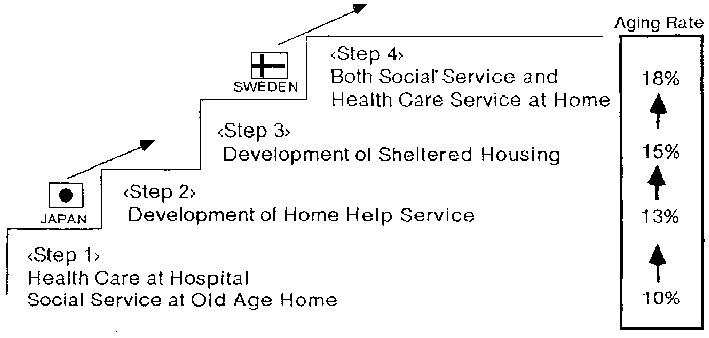| 8. |
History of the Elderly Care in Both Countries |
| 8.1 |
Comparison of the Elderly Care Development |
Table.29
|
Elderly Care Resources in Sweden and in Japan
per 100 Elderly Population(>65)
(in 1990)
|
| |
JAPAN
(
1990 )
|
JAPAN
( 2000 )
|
SWEDEN
( 1990 )
|
Sheltered Housing
|
-
|
0.5
|
2.7
( servicehus )
|
Old Age Home
|
(0.6)
*
|
(0.6)
*
|
2.4 (Ålderdomshem )
|
Nursing Home
|
1.1
|
1.1
|
2.4
( sjukhem )
|
Geriatric Hospital
|
1.0
|
0.6
|
1.0
( LåangvårdkIinik )
|
| Group Living
|
- |
- |
0.3
|
Facilities for
Health Service
for Elderly ***
|
-
|
1.3
|
-
|
| Total
|
2.l
|
3.5
|
8.8
|
Home Helper
|
0.24
** |
0.45
**
|
4.73
** |
*
|
Old Age Home in Japan is the facility for the poor elderly who is physically independent. So this ratio is not included
to the TOTAL percentage.
|
|
**
|
number of home helpers per 100 elderly(>65)
|
***
|
Facilities for the elderly who do not need to be hospitalized
for treatment, but who need functional training, nursing and
care for rehabilitation. In general patients can stay here
maximum three months. But Actually patients can not move
back home so easily.
|
|
- Sheltered Housing, Home Health Care, Nursing Homes -
|
|
(1970's
in Sweden, 1994~1998 in Japan)
|
| *1970's(14%-16%) in SWEDEN
|
In this period in Sweden, the following service
spread rapidly.
Home Help, Sheltered Housing, Home Health Care(Primary Care) ,
Nursing Home and so on.
| *1994(14%) - 1998(16%) in Japan
|
In this period in Japan, the following service are
planed to spread. Home Help, Sheltered Housing, Nursing Homes, Day-Care Centre, Facilities for Health Service for Elderly and so on.
Except the facilities for health service for elderly, almost the same service are planed to spread in Sweden and in Japan.
It is interesting that the big institutions like
nursing
homes(four beds in one rooms) are built in Japan. In Sweden also
in 1970's many big nursing homes were built and later the quality
of life of such big institutions became the problem. I think in
Japan we also face the same problem.
10
years
later, the big nursing homes(four beds in one room) will be the big problem.
| |
- 24 Hours Home Help, Technical Aid,
Integration of Home Health Care and Home Help -
|
| |
(1980 s 1990 s in Sweden and 1999-2004 in Japan)
|
| *1980's(17%) - 1990's(18%) in Sweden
|
In this period in SWEDEN, the following services
spread. Night Patrol, Day-Care Center. Home Health Care, Technical Aid,
Group Living, Modern Old Age Home. And the integration between
the sociaI service and the heaIth care wiII become very important .
| *1998(17%) - 2004(18%) in Japan
|
Through the comparison of both countries, I think
that the
elderly care system in each country mainly depends on the aging
rate. So if I can learn the development of the elderly care in Sweden in 1980's - 1990's. I can roughly find that what kind of elderly care resource will be needed in Japan in 1998 - 2004.
For example, night patrol, district nurse system and
technical
aids and group living will be needed in Japan also.
And the integration of the health care and the social service will become
very important , too. And the QOL at the nursing homes and the
geriatric hospital will be needed as their own "home". The single room at the institutions will be needed.
The need of elderly care has become bigger and bigger
day by day. But the problem is that the speed of aging in Japan is so quick that it is difficult for the Japanese people to change the
way of thinking and invest more money for the elderly.
| 8.2
|
The Development Process of the Elderly Care
|
From the comparison in both countries, I can guess
that the aging rate is the more important factor which influence the
elderly care system than the cultural difference and the national
character difference.
It means t hat at any countries when the society is
industrialized and the aging rate increase, the families become
to unable to take care of the elderly without the help of public
service like Figure.14.
The aging rate and the extent of the industrialization influence
each other and regulate the society's need about elderly care.
Figure . 14
The Developvent of the Elderly Care Style

In other words, the elderly care in Sweden and in
Japan develop, in general, with similar development process as follows.

Why the elderly care development process have the
similarity in Japan and in Sweden? It is because both Sweden and Japan
have the same interest "better quality and less cost". Both
countries have the same interest, so the trend will become similar.
| Table.30
|
The Difference of the Elderly Care in Different Society
|
|
Common
Society
|
Aged Society
|
| Health Care
|
Hospital Oriented
|
Primary Care Oriente |
| Institution
|
Hospital-Like Atmosphere
|
Home-Like Atmosphere
|
| Home Help
|
Only Day-Time. Week Day
|
24 Hours Every Day
|
|
Separate from
Home Health Care
|
Cooperate with
Home Health Care
|
| Concept
|
Length of Life
|
Quality of Life
|
| Aim
|
To
Survive
|
To Enjoy Life
|
Through the process in Figure.15 from step.1 to
step.4, and
through the development from the elderly care at the common
society and to the elderly care at the aged society in table.29,
the most important point is that the development means not only
the "better quality of life for the elderly" but also the
"less
cost" . The Swedish model is called "unique" model, but
it has
aimed at the true efficiency, so I think that the Swedish model
is a "general" model for the aged society.
Of course, it is a discussion whether Japan should
provide all these services by public sector like in Sweden or not. And the percentage of housewives in Japan will not decrease like in Sweden. So I do not think that the Japanese elderly care will
or should be the absolute same as Swedish Model. But by learning the development process of the Swedish elderly care, I can understand how much resources are needed for the future elderly care model in Japan.
|